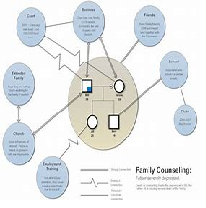
These instruments can show the family structure, the culture, the health cycle, relations and interrelations. Genograms are a bit more complex than ecomaps and do not focus on. The genogram gives a graphic representation of the family composition and the basic relationships in at least three generations, elaborated through symbols. Using a genogram, one is able to better understand hereditary and pervasive familial patterns. It can be used by the health family team as a way to approach the family, in this way the family is active in the assessment process. The family genogram is a format for drawing a family tree that records information about family members and their relationships during at least three generations (McGoldrick, 2016). It is used to: (1) determine other people and networks in the client’s or family’s social setting and the means. Then these instruments are possible tools to acquire and put in order the families' information for the Family Health care. A paper-and-pencil figure of an ecological network where a client or family belongs, along with the major structures, and the associations that influence and are influenced by the client or family, is termed as an ecomap. Health promotion can be achieved through the establishment of daily. The family is comprised of a recently divorced mother, S.W., and her two children, which are both school age boys, A.W. Both genograms and ecocards can be filled in by mental health clinicians and healthcare professionals to help diagnose and. Genograms are a little more complex than Ecomaps and do not focus on the social environment, but stick to the family and extended family history. The instruments application made some information available about the families and their relationships and the relation with the community. Like genograms, ecomaps use a variety of symbols, shapes, and lines to show interconnections and relationship dynamics. The following illustration demonstrates my surrounding neighborhood, which consist of a single parent household. A genogram can better understand hereditary and pervasive familial patterns.


It is a descriptive and exploratory study that is supported by the literature and authors' experience about the genogram and ecomap use. The main in this study is to describe the genogram and ecomap application by families' subscript in the IV Health Family Nucleus of Ribeirão Preto School of São Paulo University, for a reflection about its use in Health Family Program. FINALLY will then analyze the ecomap and genogram. The family structure, its composition, how its members are organized and interact among themselves and with the environment, its health problems, the risk situations, the vulnerability patterns are fundamental facts to plan the family health care. ASSIGNMENT CONSIST OF DIFFERENT SECTIONS, l interviewING a family, and then illustrate their interfamilial relationships as well as their external support systems and stressors by creating a genogram and ecomap. Genogram and ecomap: possibility to use in the family health strategy. When I first came across Genograms as a student, attempting to create one was very confusing and a little overwhelming. In qualitative research of the supportive and nonsupportive interactions experienced by male family caregivers, the interactive use of genograms and ecomaps (a) facilitated increased understanding of social networks as a context for caregiving, (b) promoted a relational process between researcher and participant, and (c) uncovered findings such as unrealized potential in the participant's social network that may not be revealed with the use of the genogram or ecomap alone, or the noncomparative use of both.MELLO, Débora F. family genogram and ecomap provide family health nurses a visual of the family’s current situation which helps guide the nurse to assist the family in planning interventions that will optimize their health (Kaakinen Coehlo Steele Tabacco Harmon-Hanson 2015). Although development and utilization of genograms and ecomaps is rooted in clinical practice with families, as research tools they provide data that can enhance the researcher's understanding of family member experiences. A genogram is a graphic portrayal of the composition and structure of one's family and an ecomap is a graphic portrayal of personal and family social relationships.

This article argues for the concurrent and comparative use of genograms and ecomaps in family caregiving research.


 0 kommentar(er)
0 kommentar(er)
